化工计算与软件应用(包宗宏)2
- 格式:ppt
- 大小:1.82 MB
- 文档页数:50
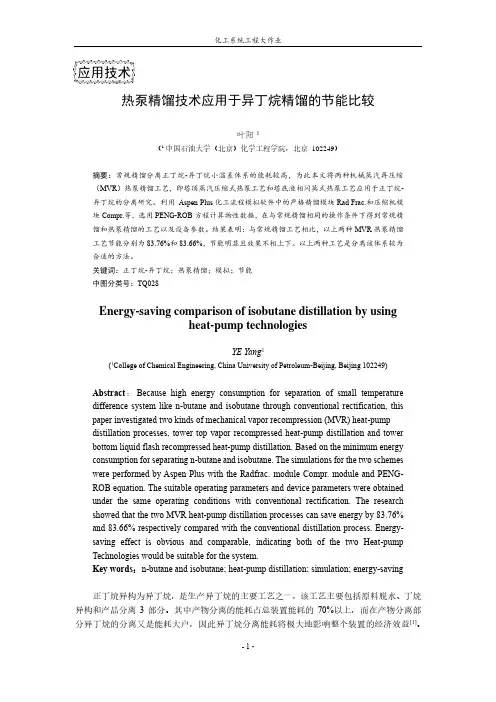
热泵精馏技术应用于异丁烷精馏的节能比较叶阳1(1中国石油大学(北京)化学工程学院,北京102249)摘要:常规精馏分离正丁烷-异丁烷小温差体系的能耗较高,为此本文将两种机械蒸汽再压缩(MVR)热泵精馏工艺,即塔顶蒸汽压缩式热泵工艺和塔底液相闪蒸式热泵工艺应用于正丁烷-异丁烷的分离研究。
利用Aspen Plus化工流程模拟软件中的严格精馏模块Rad Frac.和压缩机模块Compr.等,选用PENG-ROB方程计算物性数据,在与常规精馏相同的操作条件下得到常规精馏和热泵精馏的工艺以及设备参数。
结果表明:与常规精馏工艺相比,以上两种MVR热泵精馏工艺节能分别为83.76%和83.66%,节能明显且效果不相上下。
以上两种工艺是分离该体系较为合适的方法。
关键词:正丁烷-异丁烷;热泵精馏;模拟;节能中图分类号:TQ028Energy-saving comparison of isobutane distillation by usingheat-pump technologiesYE Yang1(1College of Chemical Engineering, China University of Petroleum-Beijing, Beijing 102249)Abstract:Because high energy consumption for separation of small temperaturedifference system like n-butane and isobutane through conventional rectification, thispaper investigated two kinds of mechanical vapor recompression (MVR) heat-pumpdistillation processes, tower top vapor recompressed heat-pump distillation and towerbottom liquid flash recompressed heat-pump distillation. Based on the minimum energyconsumption for separating n-butane and isobutane. The simulations for the two schemeswere performed by Aspen Plus with the Radfrac. module Compr. module and PENG-ROB equation. The suitable operating parameters and device parameters were obtainedunder the same operating conditions with conventional rectification. The researchshowed that the two MVR heat-pump distillation processes can save energy by 83.76%and 83.66% respectively compared with the conventional distillation process. Energy-saving effect is obvious and comparable, indicating both of the two Heat-pumpTechnologies would be suitable for the system.Key words:n-butane and isobutane; heat-pump distillation; simulation; energy-saving正丁烷异构为异丁烷,是生产异丁烷的主要工艺之一,该工艺主要包括原料脱水、丁烷异构和产品分离3部分。
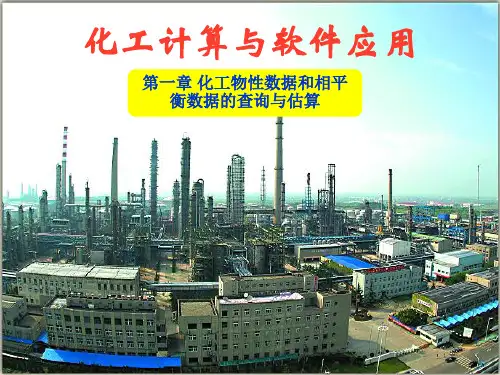
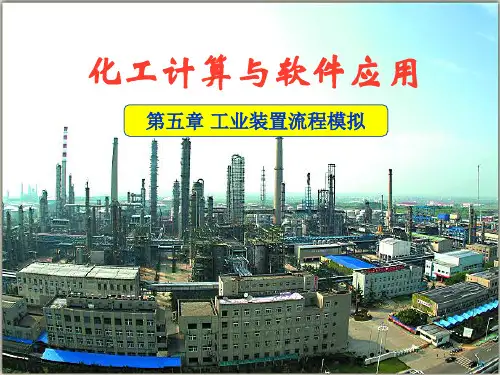
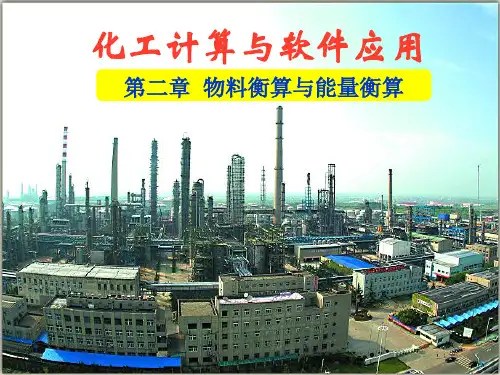
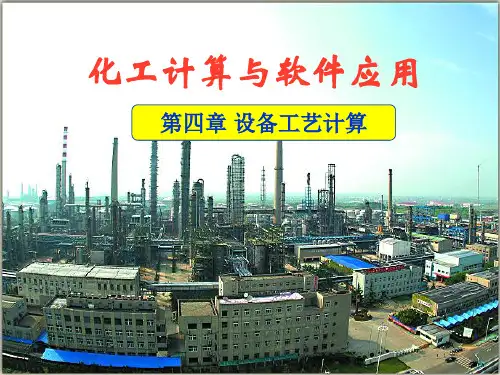
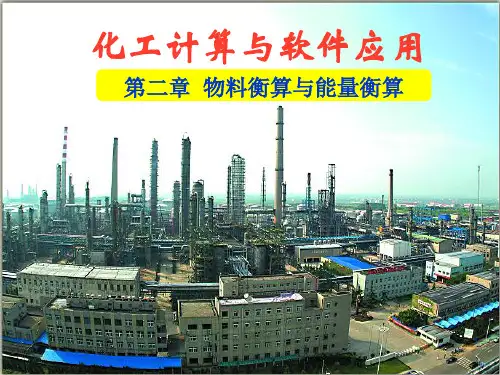

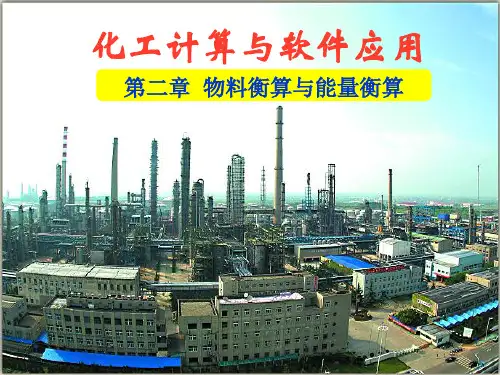
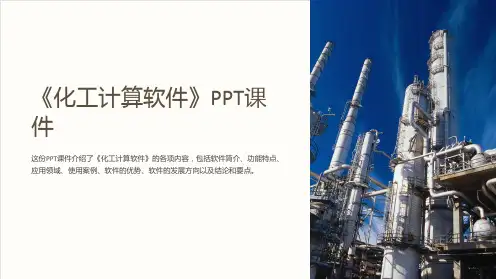
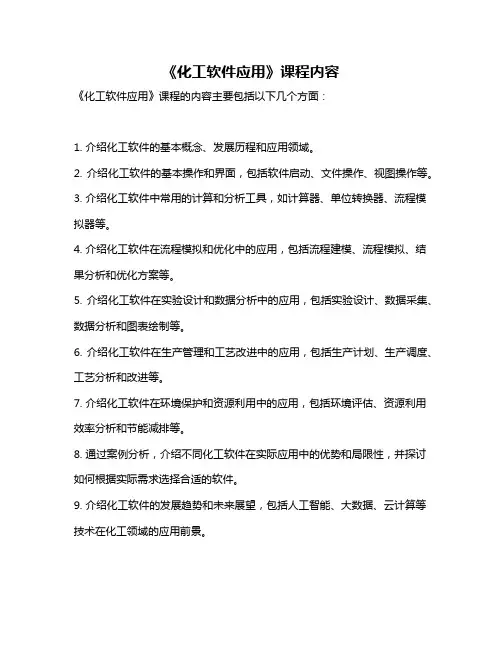
《化工软件应用》课程内容
《化工软件应用》课程的内容主要包括以下几个方面:
1. 介绍化工软件的基本概念、发展历程和应用领域。
2. 介绍化工软件的基本操作和界面,包括软件启动、文件操作、视图操作等。
3. 介绍化工软件中常用的计算和分析工具,如计算器、单位转换器、流程模拟器等。
4. 介绍化工软件在流程模拟和优化中的应用,包括流程建模、流程模拟、结果分析和优化方案等。
5. 介绍化工软件在实验设计和数据分析中的应用,包括实验设计、数据采集、数据分析和图表绘制等。
6. 介绍化工软件在生产管理和工艺改进中的应用,包括生产计划、生产调度、工艺分析和改进等。
7. 介绍化工软件在环境保护和资源利用中的应用,包括环境评估、资源利用效率分析和节能减排等。
8. 通过案例分析,介绍不同化工软件在实际应用中的优势和局限性,并探讨如何根据实际需求选择合适的软件。
9. 介绍化工软件的发展趋势和未来展望,包括人工智能、大数据、云计算等技术在化工领域的应用前景。
以上内容仅供参考,具体课程安排可能会因学校、教师和教材的不同而有所差异。

听听前辈声音,您还敢参加大学生全国化工设计竞赛么?之“三井杯”化工设计竞赛经验分享“三井杯”全国大学生化工设计竞赛至今已经举办了九届,从最初几个学校的参与到如今五个赛区二百多所高校参与,化工设计竞赛已经被大家所认可。
作为一名曾经两度参与此竞赛的成员,写出一些经验的分享,希望可以为准备参加这个竞赛的同学们提供一个参考。
1、比赛认知参与任何比赛都要先了解这个比赛的核心宗旨是什么,如果不知道比赛的核心宗旨那么怎么会取得一个理想的成绩?化工设计竞赛要求同学设计出一套工艺,并通过流程计算、设备计算、图纸绘制等一系列软件进行模拟、绘图等,最后做出文字材料。
化工设计竞赛全流程可以看作为简单的工艺包设计,因此就需要参与的同学去接触了解如何进行工程设计,而不是天马行空的任由自己的想法去完成这个竞赛。
2、组队成员很多同学都在纠结如何去进行组队,比赛需要团队成员的共同努力,因此在选取队员的时候首先应该明确他是否有能力、有毅力来坚持做完这个比赛。
在化工设计竞赛这条路上走过来的学长们有共同的体会,做比赛是一件枯燥、需要耐心的事情。
有很多团队因为其中成员的退出导致最后团队的瓦解,因此希望同学们能够在组队时认真挑选成员。
当然,这个比赛建议跨学科组队,因为需要进行工艺设计、设备设计、图纸绘制、经济概算等多方面任务,就需要相关专业的同学来完成相应的工作。
3、赛前准备很多的同学都在问要参加这个比赛都需要准备什么,都需要掌握哪些知识,都需要学习哪些软件。
借鉴了许多化工大拿的经验分享,在这个浮躁的时代,作为大学生更应该去将基础做好,不要好高骛远,更不能丢下基本原理去胡乱设计。
很多学生为了尽快的做出计算模型取得一个所谓的“无错误、无警告”的结果而忽略了化工最基本原理。
软件只是一个计算机辅助工具,它没有真正的“认知”,当你对其进行赋值后,它必然会给你一个结果,而其真正的准确与否软件无法辨别。
当你赋予不同的参数条件,软件都会为你“忠心耿耿”的计算,无论你在设计精馏塔塔压是一个大气压还是一百个大气压,只要它在计算上能通过,就是无错误的。